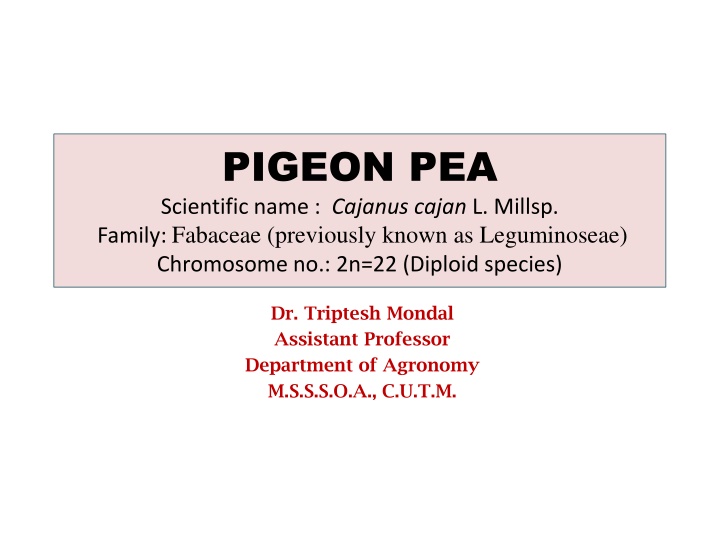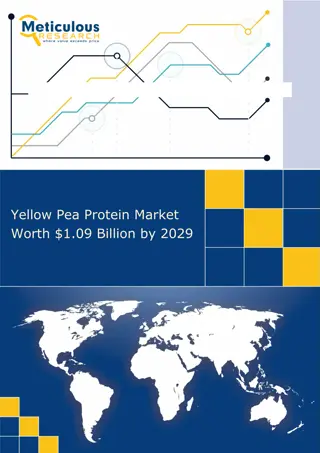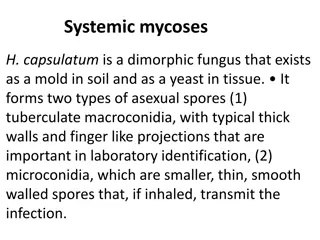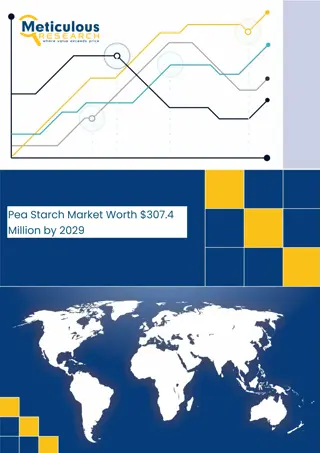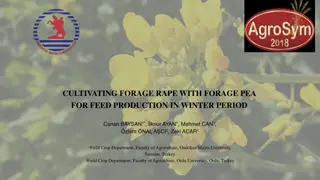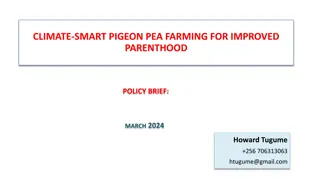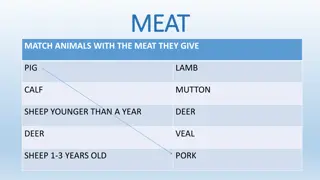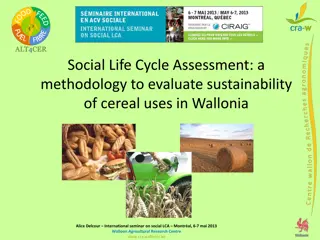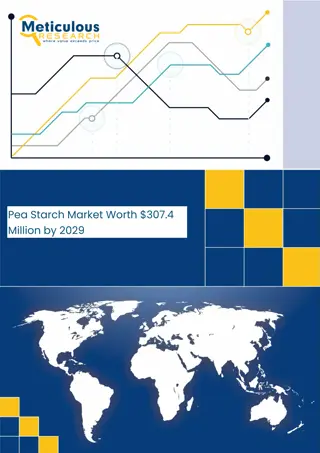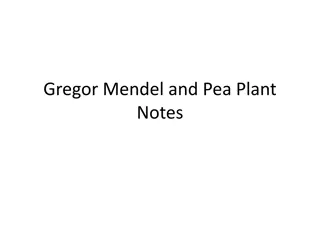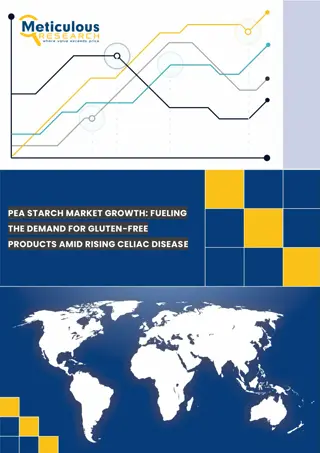Pigeon Pea (Cajanus cajan L. Millsp) - Overview, Importance, and Uses
Pigeon pea, scientifically known as Cajanus cajan L. Millsp, is a significant kharif pulse in India. It is rich in protein, carbohydrates, fiber, and essential minerals. The plant provides nutritious grains, cattle feed, and fuel. Pigeon pea withstands soil moisture deficits, making it vital in dryland agriculture. Originating in Africa or India, it has different cultivated types with varying characteristics.
Download Presentation

Please find below an Image/Link to download the presentation.
The content on the website is provided AS IS for your information and personal use only. It may not be sold, licensed, or shared on other websites without obtaining consent from the author.If you encounter any issues during the download, it is possible that the publisher has removed the file from their server.
You are allowed to download the files provided on this website for personal or commercial use, subject to the condition that they are used lawfully. All files are the property of their respective owners.
The content on the website is provided AS IS for your information and personal use only. It may not be sold, licensed, or shared on other websites without obtaining consent from the author.
E N D
Presentation Transcript
PIGEON PEA Scientific name : Cajanus cajan L. Millsp. Family: Fabaceae (previously known as Leguminoseae) Chromosome no.: 2n=22 (Diploid species) Dr. Triptesh Mondal Assistant Professor Department of Agronomy M.S.S.S.O.A., C.U.T.M.
IMPORTANCE & USES Common names- Arhar, tur, redgram, congo pea, gungo pea and no eye pea Pigeon pea is the most important kharif pulse in India. Its grains are highly nutritious and rich in protein (21.7%), carbohydrates, fibre and minerals such as iron (Fe) and iodine (I). It is mainly eaten in the form of split pulse as dal. The outer covering of its seed together with part of kernel provides a valuable feed for milch cattle. The grains are rich in essential amino acids like lysine, tyrocene, cystine and arginine. The husk of pods and leaves of the plant are used as valuable cattle feed. Woody parts of the pigeon pea plant are used as fuel. The ability of pigeon pea to produce economic yields under soil moisture deficit makes it an important crop of dry land agriculture.
ORIGIN & HISTORY: It was introduced in the African continent about a 1000 years ago where different strains developed. True wild pigeon pea has not been found anywhere. They exist mostly as remnants of cultivated species. The closest wild relative of pigeon pea Atylosia canifolia Haines has been found in some localities in east India. Most other Atylosia spp. are found scattered throughout India. In Africa, Cajanus kerstingii grows in the drier belts of Senegal, Ghana, Togo and Nigeria. Pigeon pea occurs throughout tropical and subtropical regions and in the warmer temperate regions from 30 N to 30 S. So, the origin of pigeon pea is either north-eastAfrica or India.
CLASSIFICATION: All the cultivated pigeon pea types fall into 2 groups. These are: 1. Cajanus indicus var. bicolor: This group includes generally late maturing varieties, having tall, bushy plants, flowers are yellow; purple streaked pods are dark coloured each with 4 or 5 seeds. The standard which is the largest of 5 petals in the flower, possesses red vein on the dorsal side. 2. Cajanus indicus var. flavus: This group includes early maturing varieties, having smaller plants, yellow flowers, plain pods with 2 to 3 seeds.
BOTANICAL DESCRIPTION: Stem: It is an erect, perennial shrub, mostly grown as annual for seeds. Stem is strong & woody. The plants generally 1-4 m in height. In most of the types, branching begins from the sixth to tenth node, i.e., from 15-25 cm above ground. Root: Root system consists of a deep, profused tap root extending up to 2 m below the soil surface with numerous laterals and secondary branches. The length of the lateral roots differ with the variety. Leaves: Leaves are trifoliately compound; central leaflet longer than lateral ones. The leaflets are entire and densely silky on lower surface. Stipules are small, lamina hairy with the under surface greyish due to dense hairs.
Inflorescence: The inflorescence is an axillary raceme often forming terminal panicle. The flowers are distinctly papilionaceous. The flowers are self pollinated, pollination takes place before the flowers open. Pods: The fruit is a pod . These are vary in length and width and nature of markings. The length varies from 5-10 cm and width from 0.6-0.9 cm. The pods vary in colour from green to dark brown. Seeds: The seeds within the pod vary in number, but there are usually 4-5 in each pod in late maturing varieties and 2-3 in early maturing varieties. Seeds are round or lens shaped. The colour of seed coat being dirty white to silver white and the cotyledons are yellow coloured.
Pods Seeds
AREA, PRODUCTION, PRODUCTIVITY & DISTRIBUTION: India ranks first with about 79% of the world area and 75% of production having 5.23 mha of area, 4.32 mt of production and 825.7 kg/ha of productivity (FAOSTAT, 2021). Pigeon pea ranks sixth in area and production in comparison to other pulses of world. In World, the cultivated acreage of pigeon pea is 6.36 mha along with 5.48 mt of production and 861.6 kg/ha of productivity (FAOSTAT, 2021). It is grown in world over mostly in tropical & sub-tropical countries of Asia, Africa, Carribbean island nations for grain, green manuring, fodder and forage purpose. In India, the crop is extensively grown in Maharashtra, Uttar Pradesh, Madhya Pradesh, Karnataka, Andhra Pradesh and Gujarat. These states together occupy 62% of the area & contribute 73% of total production of India. In India, it is mostly grown as rainfed crop in dryland areas. Uttar Pradesh alone contributes about 20% of the total arhar production of India.
VARIETIES OF PIGEON PEA Long duration varieties (>180-300 days): Amar, ICPL-151, Narendra Arhar-1, Azad, Bahar Medium duration varieties (>150-180 days): Pusa-855, Pusa- 9, Manak, Paras, ICPL-87, BRG-1 & 2, ICPL 332 (Abhaya), ICPL 8719 (Asha), Maruti( LRG-41) Short duration/Early varieties(100-150 days): CO-6, UPAS- 120, T 21, Pusa ageti For kharif , never choose early and extra early varieties as the rains coincide with flowering and pod formation. Generally medium duration varieties are recommended for kharif. Late maturing varieties during kharif may suffer from terminal stress. In A.P., LRG-30 (Palnadu), ICPL 85063 (Lakhsmi) are the promising varieties both in kharif and rabi. Early maturing varieties for rabi: CPL-87 ICRISAT varieties ICPL 870, ICPH-8 (1st Hybrid in the world in 1991)
SOIL & CLIMATIC CONDITION SOIL: It can be grown on a wide range from sandy to heavy clay loams. The crop performs well on fertile well drained loamy soils. Saline, Alkaline and waterlogged soils are not suitable for pigeon pea. But some tolerant cultivars are now available. CLIMATE: It is a quantitative short day flowering response plant i.e., the onset of flowering is hastened as day length shortens. It can tolerate heat and drought. It can successfully grow in areas receiving only 65 cm annual rainfall. It prefers fairly moist and warm climate during vegetative period (i.e., annual average rainfall of 60-100 cm with moist conditions for the first 8-10 weeks) and cool and dry period during reproductive period (i.e., flowering and pod filling). It is susceptible to frost. The cloudy weather and excessive rainfall during flowering damage the crop to a great extent due to poor pollination, poor pod development and infestation of pod-borer. A temperature range of 18-27 C is desirable. However, there are varieties which can tolerate < 10 C and >35 C.
SEEDBED PREPARATION A fine seedbed with friable soil with optimum moisture condition is needed for better germination. It is necessary because most of the kharif pulses have epigeal germination. Hardy or cloddy or crusty surface layer affect proper germination and hinder the seedling emergence. A deep ploughing with soil turning plough followed by 2-3 cross harrowings and proper land levelling should be given to ensure uniform irrigation and proper drainage. In intensive cropping systems, planting of pigeon pea in broad bed and furrow method with a provision of post- monsoon irrigation at 0.4 IW:CPE ratio improved the yield over flat planting and unirrigated pigeon pea.
PARTICULARS OF SOWING Sowing time: In kharif, with the onset of monsoon in the later part of June to early July (rainfed condition) & 1st fortnight of June with pre-sowing irrigation (irrigated condition) In rabi, 1st fortnight of August In pre-kharif, 1st fortnight of December The sowing time depends upon the duration of variety and rainfall pattern of the region, Early sowings are always better. Sowings should be planned in such a way that flowering and pod formation should not coincide with peak rainy period. Seed treatment: Seed treatment with fungicides like Bavistin 1g/kg seed or captan or Thiram @2.5 g/kg before sowing effectively reduces the incidence of both seed and soil borne fungi. Seed treatment with rhizobium culture can increase the yield upto 20-30%. Seed rate: Long duration varieties: 8-10 kg/ha Medium duration varieties: 10-12 kg/ha Short duration varieties: 12-15 kg/ha
Spacing: The optimum spacings are as follows: Long duration varieties: 60-120 cm 15-20 cm Medium duration varieties: 40-60 cm 10-15 cm Short duration varieties: 40-60 cm 10-15 cm But row to row spacing of 60-75 cm and plant to plant spacing of 15-20 cm are followed generally. Depth of sowing: 10 cm Method of sowing: Seeds are sown behind the plough and seed drilling Plant population: Itdepends on the following factors: 1. Sowing time: In kharif, plant population is less than rabi because of more canopy growth in kharif. 2. Fertility status of soil: Higher plant population can be used under fertile soils than on infertile soils. 3. Rainfall pattern: In regions which is having well distributed rainfall, maintain high plant population than in the areas with low rainfall. 4. Varieties: Variety with less branching require higher plant population. 5. Duration of the crop: Longer duration varieties require less plant population because of more canopy development. Generally, plant population of 3 plants/m was found optimum for some HYVs in central Karnataka while 10-11 plants/m to be optimum at Tirupathi.
MANURES & FERTILIZERS: Manures: 5 tonnes/ha of FYM in Kharif. The inbuilt mechanism of biological nitrogen fixation enables pulse crops to meet 80-90% of their N requirements, hence a small dose of nitrogen @ 15-25 kg N/ha is sufficient. Phosphorus: 60-80 kg P O /ha for phosphorous deficient soils at sowing. In pigeon pea-wheat and rice-pigeon pea cropping systems, phosphorus applied to wheat and rice may meet the need of P in succeeding pigeon pea to a large extent. Potassium: 20kg K O/ha for potassium deficient soils by placement at sowing. Application of 20 kg S/ha increases the grain yield of pigeon pea. 25 kg ZnSO /ha application as basal is also beneficial as most of indian soils are Zn deficient. Bio-fertilizers: for early and effective nodulation, seed treatment with rhizobium is recommended (@ 250 g/10 kg seed).
IRRIGATION WATER MANAGEMENT The critical periods for Irrigation are flower initiation and pod-filling stages. Intensive cropping of pigeon pea can also be achieved under tube well irrigation, arising at a highest production of 4 tonnes/ha. Redgram grown in Kharif does not require any irrigation and often require proper drainage to remove excess water from the field as pulses are very sensitive to waterlogging. The crop grown in spring/summer and winter do require irrigation when the soil moisture becomes limiting. In short duration pigeon pea, 2 irrigations at flower initiation and pod-filling stages, respectively or irrigation at 80 mm CPE proved equally effective.
WEED MANAGEMENT Broad-leaved weeds: Amaranthus viridis, Commelina benghalensis, Phyllanthus niruri, Euphorbia hirta, Digera arvensis etc. Sedge weed: Cyperus rotundus Grassy weeds: Setaria glauca, Digiteria sanguinalis, Echinochloa sp. etc. Pigeon pea is a slow-growing crop during the first 6-8 weeks. Inter-cultivation or hand weeding depending on the intensity of weed infestation at about 3-4 weeks after sowing is adequate to check the weed growth. The recommended herbicides application of pendimethalin (Stam F-34) @ 0.9 kg/ha, alachlor (Lasso) @ 2 kg/ha, pre-plant application of fluchloralin (Basalin) @ 0.75-1.0 kg/ha. Integrated weed management is the best approach to control weeds in pigeon pea. are pre-emergence
HARVESTING, THRESHING & POST-HARVEST MANAGEMENT The redgram is said to be indeterminate in growth habit where the flowering goes on continuously over the months on the same plant. Flowering, unriped pods & already developed pods are present at the same time on a plant. Hence, the crop is harvested (when pods become brown or brownish-yellow from green) in 2-3 pickings. The whole plants are cut when most of the pods are dried. Then the plants are bundled and staked for one week for the purpose of post harvest ripening of unriped pods after that the dried pods are beaten with sticks and then the seeds are separated. Seeds are better to go for processing before storing. At first, dry the seeds till the moisture content comes to around 10-12%. Then grading is done by separation of shrivelled and broken grains obtained during threshing. Power operated hullers or processors are available for splitting of seeds in to dal. The dehulled operation is usually performed in 2 steps: the first involves loosening the husk from cotyledons and the second involves removing the husk from cotyledons and splitting them using a roller machine or stone chakki. After processing, one more cleaning and separation of broken cotyledon is necessary for quality improvement of the produce. The processed material may be stored in gunny bags. Bags should stored on wooden platform in the well-ventilated rooms. Finally, the stored split cotyledons (dal) are cooked to make thick soup primarily for mixing with rice.
CROPPING SYSTEMS Intercropping: Sorghum + Pigeon pea Maize + Pigeon pea Pigeon pea + Groundnut Sequential cropping: Pigeon pea - Wheat/Mustard - Greengram Pigeon pea - Greengram - Wheat/Mustard Maize - Pigeon pea Pigeon pea - Lentil Pigeon pea - Sugarcane
YIELD ATTRIBUTES & YIELD Yield attributes: Number of plants/m Number of branches/plant Number of pods/branch Number of seeds/pod 1000-grain weight Yield: Grain yield in irrigated condition is 2.0-2.5 t/ha and stick yield is 5.0- 6.0 t/ha; In rainfed condition, grain yield varies from 1.0-1.5 t/ha and in case of inter/mixed cropping is 0.5 0.6 t/ha.
